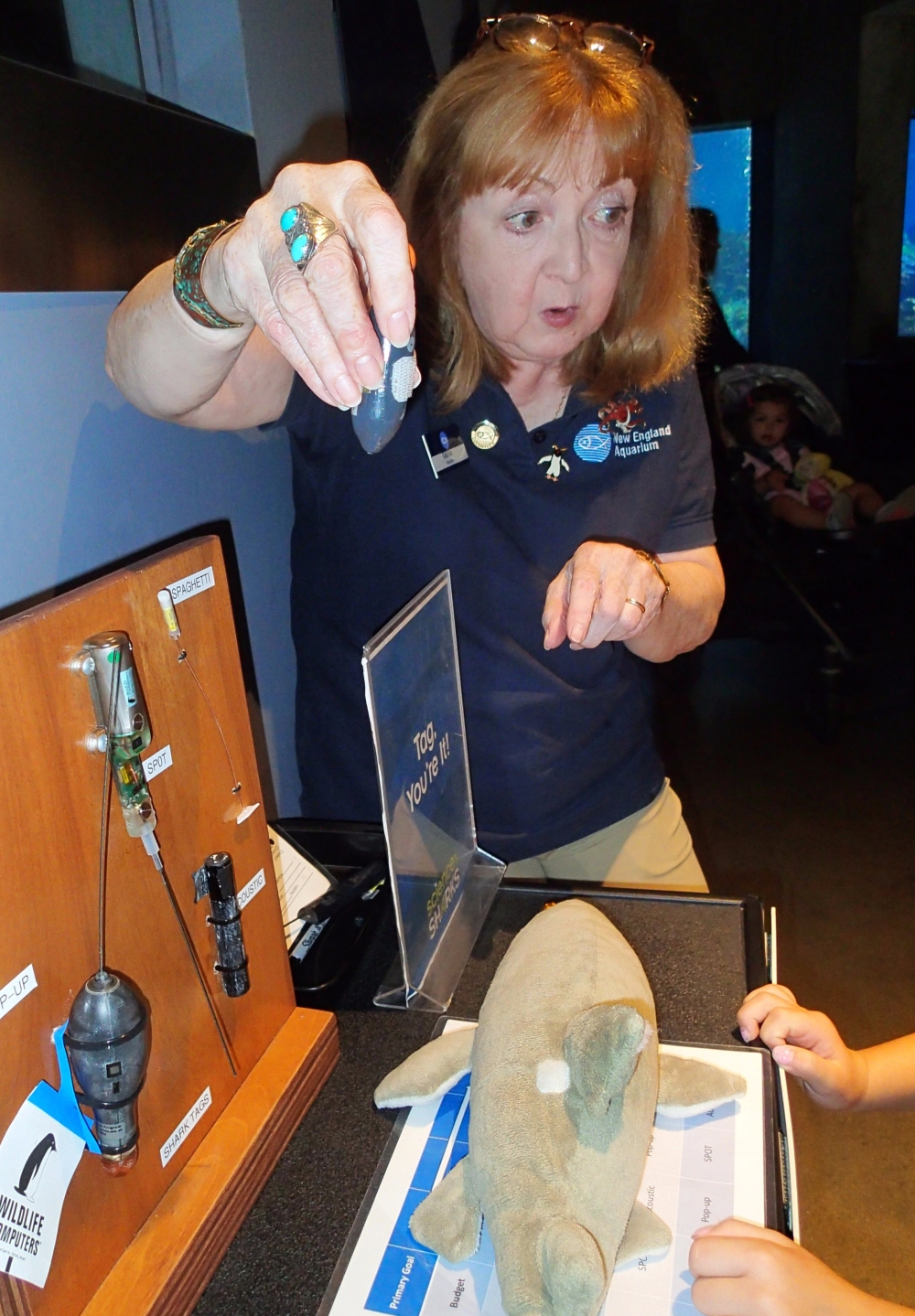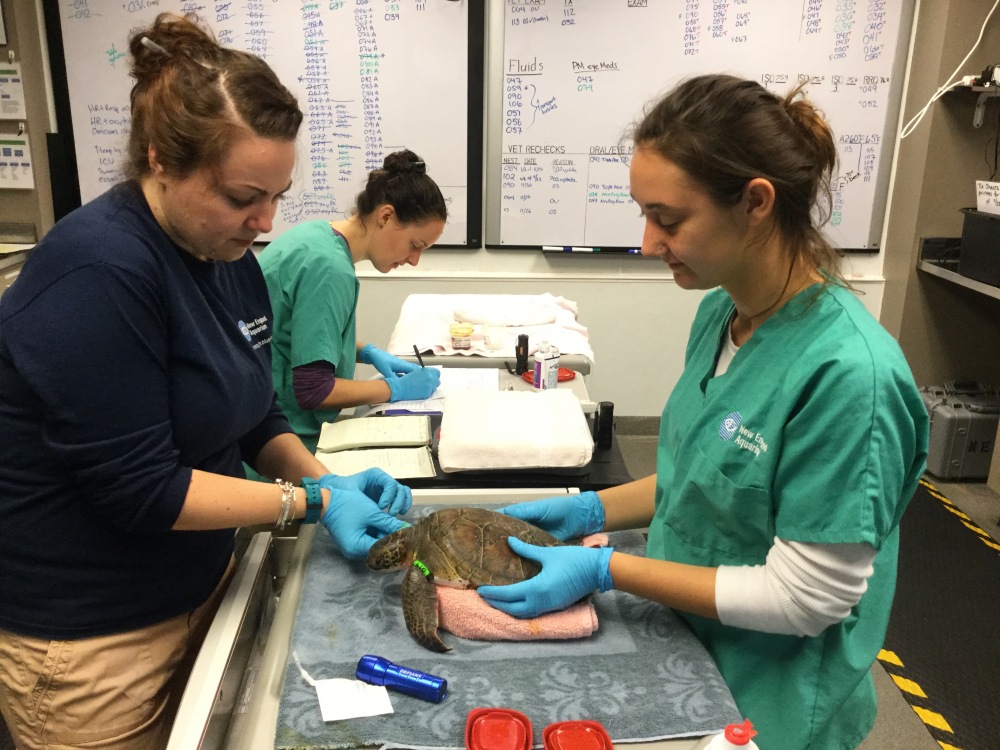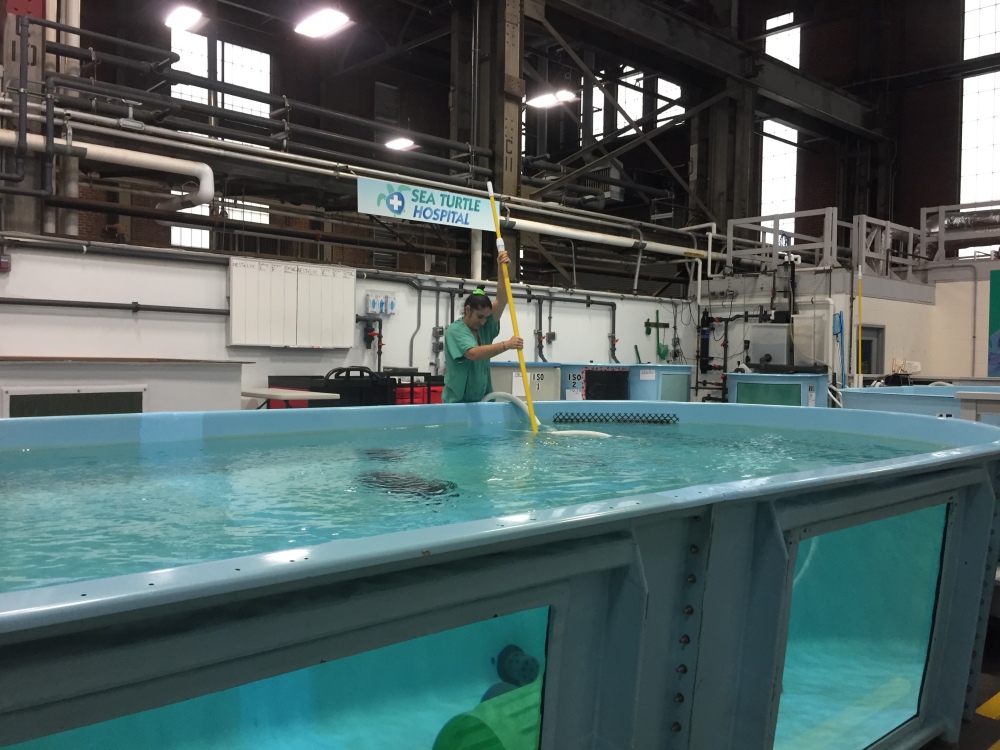I met with Goldie on a rainy Columbus day at the Aquarium. She, an experienced volunteer and educator with eight years of experience, met with me, a new volunteer with only 3 months under my belt, to talk about her experience as a TERV (Turtle Emergency Response Volunteer). Goldie had just finished another volunteer shift, and despite the overwhelming crowds at the aquarium that day she still had a bounding amount of energy reserved to describe her passion about the sea turtle rescue program. I was an excited sea sponge, ready to soak up her wisdom and hear her stories about rescuing sea turtles from a dark and cold fate. While I expected some good stories, I was flabbergasted by the depth of knowledge Goldie had surrounding sea turtles and marine life in general. Here’s our conversation:
How long have you been involved with the Aquarium?
It’s getting close to eight years now. When I retired from my other job, I realized I still wanted to be involved with education, so I thought the Aquarium would be a good fit.
Especially since your regular volunteer shifts involve going to all of the exhibits! You have to learn about multiple animals.
That’s the thing, you’re always learning! There are always new animals coming in, or animals you didn’t really notice before, and you think, “Oh, okay! Let’s learn about that”.

You’ve been a TERV for three turtle stranding seasons now. Describe some of your daily activities as a TERV. Anything that surprised you about the experience/the work you do?
Well, the first year you work you have at least six days of training. It’s very educational and informative, yet intense. It helps you remember everything from one year to the next. Things are very detailed and geared towards the safety of not only the turtles, but the volunteers themselves.
Not only do you have to learn about the conditions sea turtle face, you learn how to correctly hold a sea turtle at the correct angle so it’s breathing won’t be impaired by the water spilling out of the shell. And there’s a huge amount of training just on cutting food! Who knew cutting up squid was so demanding? For instance, you have to remember to pull out the pen (the only hard part of the body) and leave it separately. You have to chop the squid up just so to try and entice these sea turtles, that are starving to death, to eat.
The rescue procedure is very precise for the turtles’ well being. You measure out the number of grams a turtle is eating, and that’s recorded daily. You spend a lot of time cleaning. The fun part is spending time with the turtle, sympathizing with them, and holding them. But the majority of the time is making sure the
area is clean: scrubbing down walkways and mats, doing laundry, folding towels the proper way so turtles can rest on them, running blood samples, etc.
Tell me about the people you work with in Quincy.
They are amazing! I mean I can’t say enough positive things about the staff that works there because they’re so focused. They are a fun-loving bunch, but there is an incredible focus on what’s the best thing to do for the turtles. It’s a great team environment.
And is this the staff for the Mass Audubon Society or people who work for the Aquarium?
Mass Audubon prepares the turtles, and transports them in banana boxes to our place in Quincy. Then you have volunteers who are the beach-walkers, the drivers who bring them to Quincy, and finally you have the Quincy staff. They consist of veterinarians from the Aquarium, and vet-techs who volunteer on their off time to help. The dedication of some volunteers are astounding. You hear about the vast amount of people who go out in their waders at 2am in ice cold water in December to help save turtles. I realized that whatever sacrifice I had to make was nothing in comparison (laughs).

Tell me a little about the turtles!
When you help the vets with their exams, you can become attached to these turtles you are helping. You find yourself days later coming in and asking how turtle 531 is doing! You see turtles come in who are so damaged and you wonder how they will survive. And surprisingly, a huge number of them make it through. Sometimes turtles will have a longer recovery, and have to stay in our facilities until the summer to recover. Others will be sent to other aquariums because they cannot be released back into the wild.
I was shocked by the tenacity of these turtles. You’re impressed with turtles to begin with, but then you see them come in in these conditions, and you wonder how they can even possibly still be breathing. I started in 2015, which was the year of record turtle strandings. The facility in Quincy is huge, but that
year it was packed with turtles. I was surprised by the volume of Kemp’s Ridley turtles, and the amount of young turtles, coming in. I like to think that we’re seeing more of them because our conservation efforts are working.
You’ve told me about the training and the daily work you did as a TERV. Was there anything about the work that surprised you? Was the work different from what your assumptions were going in?
It was different; I didn’t know how much of the whole routine I would be shown, and I really felt like I was exposed to the whole scope of turtle rescue. I got to see things ranging from the nitty-gritty of clean up, to holding a turtle and hearing about what is going to happen with it. I loved how they have volunteers do a variety of tasks throughout your workday, so you’re not just stuck on clean up.

What have you learned about sea turtles and the effect humans can have on their condition?
I learned how difficult it is for our Massachusetts sea turtles to reach maturity. They are late maturers, and won’t mate until age 14 or 15. They start out the size of a quarter, and have so many predators at that point. Add habitat loss to the mix and the odds of survival decrease. I also learned that while we imagined sea turtles far away from shore, the Kemp’s Ridley turtles actually stay close to the shore and hunt things like crabs. So our habitats are shared.
However, when I found out more about the conservation efforts in Texas and Mexico I became more optimistic. These are huge turtle breeding areas, and to see [these regions] come out with an educational-awareness approach, instead of a rampant use of resources, is heartening. There is such a positive movement
happening towards protecting these animals.
Climate change is another issue that affects the sea turtle population. The warming of the climate can actually change the gender distribution of sea turtles. In reptiles, most of the eggs are undifferentiated and don’t have X or Y chromosomes. In the development process, there’s a certain time when the temperature of the water (or the area of the nest) will determine whether a turtle will be a male or female. Hot temperatures generally lead to more females, while the colder temps produce males. With climate change, you are adding more heat to turtles nest, which results in the skewing of the population. There are studies that are finding that there are more females developing in the nests. So if we don’t do something about temperature, we will see a significant imbalance.
Tell me more about the sea turtle protection movement. How can we make a diference at home?
You know, turtles have been around for 240 million years and humans have only been around for around 2 ½ million years, so I think we owe it to them to do our part.
In places like Texas, there was a conversation with fisherman about how their nets caused turtle entanglements. Because of this, the fisherman not only started to add turtle-excluder devices (TEDs) to their nets so turtles could escape, but they also donated money to turtle centers for research.
In regards to habitat loss, it helps to get involved in any community group regarding waterfront development. There are many concerns with waterfront development. Look to see if [developers] are splitting up the habitat so turtles can’t move from one good area to another. Also see if they are building up too much on the shoreline; if they do, there’s not enough habitat for the animals to nest. Also pay attention to how much traffic is allowed on these beaches; in Texas and Mexico they roped off certain areas for turtles so they wouldn’t be trampled by ATVs.
We tend to think of government departments like Fish and Wildlife taking the lead to get involved, but we (individuals) can get involved too by doing research and joining community groups! (Editors note: Getting debris out of the ocean through coastal cleanups, and using reusable bags/bottles, is always helpful!) In addition, doing any activities that can cut down on our carbon footprint in regards to climate change will help as well. You can also support conservation efforts like project head-start.
Let’s end on a happy topic! Are there any turtles that stand out during your TERV experience?
There was one turtle that I watched for a period of two weeks during my first year of volunteering. In the beginning, this turtle was brought in basically catatonic: it was not moving, not eating, and it was diagnosed with an infection which meant it was put in quarantine. I would watch it in the quarantine tank, where it would be sitting at the bottom of the tank not moving. We would bring it up for air and then it would sink to the bottom of their tank again.
The next time I came in, it had been moved to a swimming tank, so it was in with other turtles. It still wasn’t eating much, but I knew at least that it wasn’t infected anymore. And then I eventually came back and it was eating and it was looking like it was fine! It was one of the 85% or so of rescued turtles that made it, and it was released. For me it was astounding. I couldn’t believe anything could go from not moving, not eating and being severely infected to being released back into the wild, healthy once more. But then, it’s the whole story of how these animals are remarkable. They have a zest for living!
Special thanks to Goldie for sharing her stories!
You could join Goldie as a Turtle Emergency Response Volunteer! Apply online here.